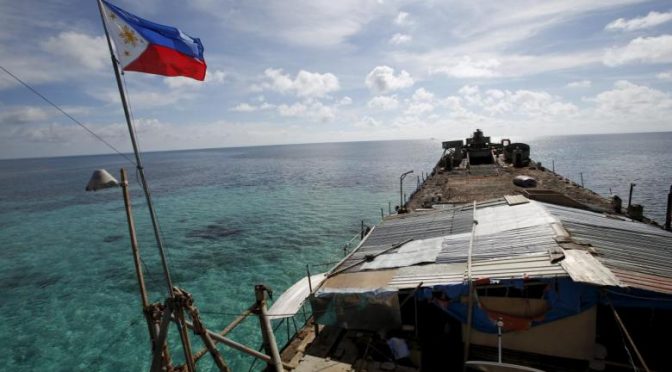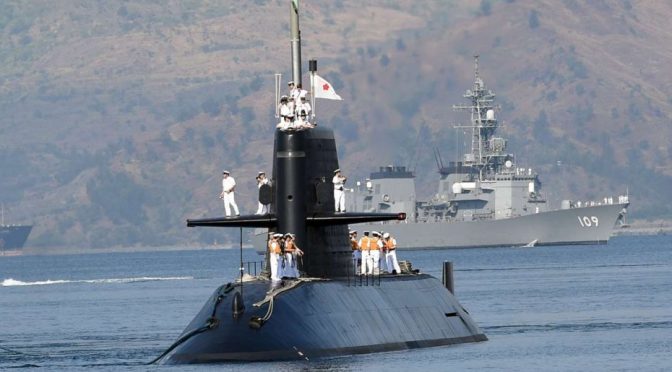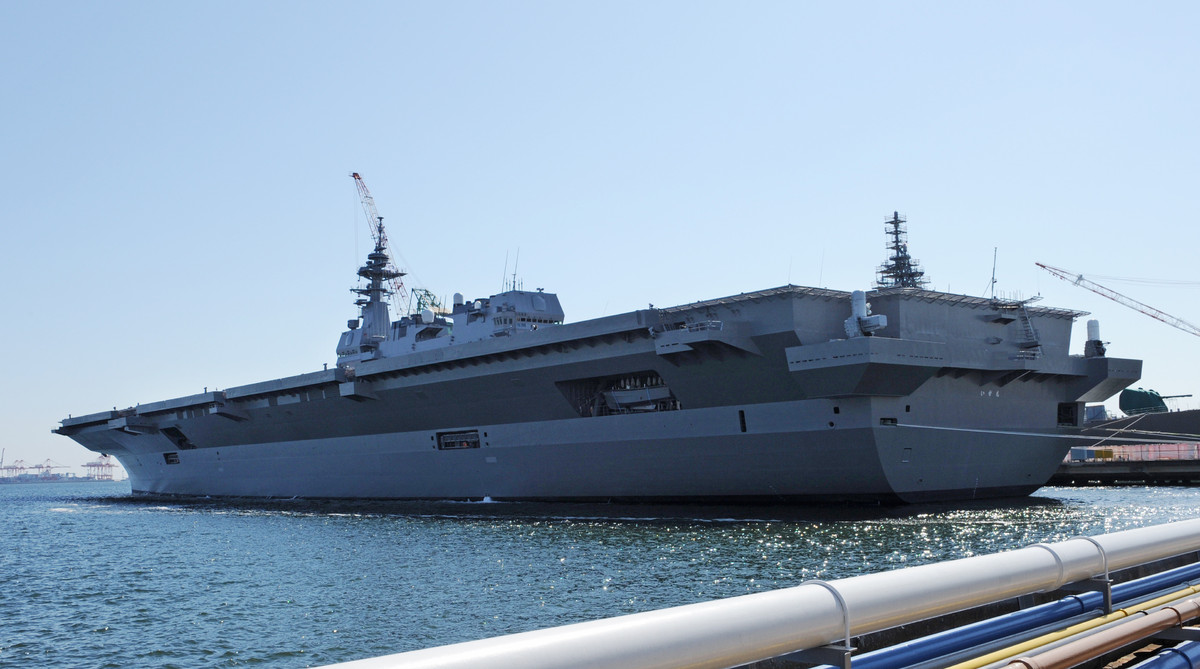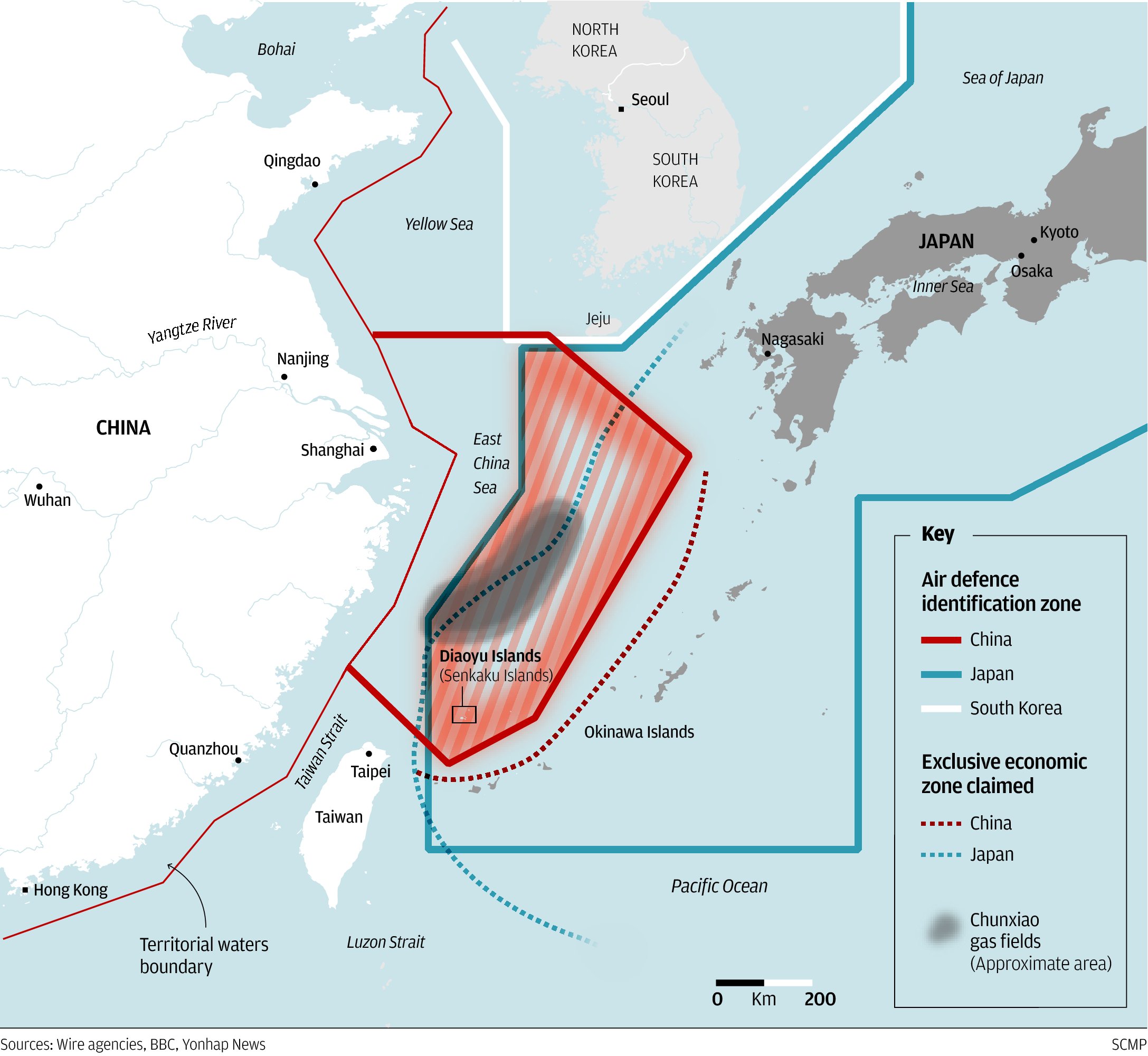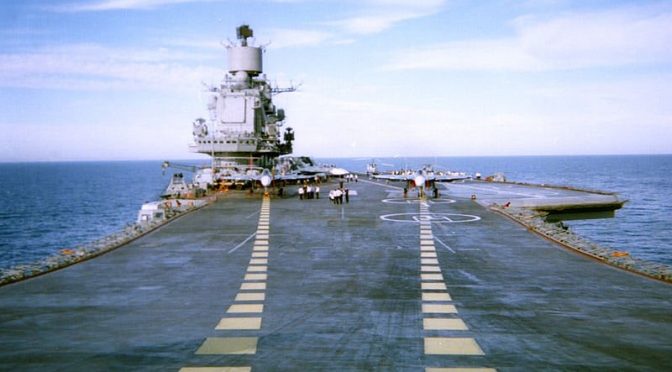This piece was originally published by The Jamestown Foundation, and is republished with permission. Read it in its original form here.
By Elsa Kania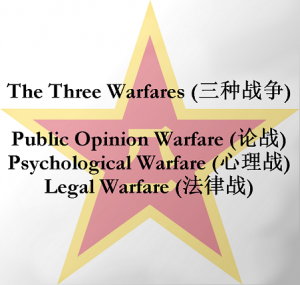
Beijing’s response to the unfavorable South China Sea arbitration outcome has highlighted an important aspect of its military strategy, the “three warfares” (三战). Consisting of public opinion warfare (舆论战), psychological warfare (心理战), and legal warfare (法律战), the three warfares have been critical components of China’s strategic approach in the South China Sea and beyond. In peacetime and wartime alike, the application of the three warfares is intended to control the prevailing discourse and influence perceptions in a way that advances China’s interests, while compromising the capability of opponents to respond.
Beijing has sought to delegitimize the arbitration process and achieved some success in undermining the coalescence of consensus in support of the ruling, while engaging in coercive signaling and deniable attempts to punish the Philippines. China’s response has also included “regularized” “combat readiness patrols” over the South China Sea by H-6K bombers, as well as Distributed Denial of Service (DDoS) attacks against Philippine government websites (China Military Online, August 6; China Military Online, July 19; InterAksyon, July 15). Consistently, Beijing has attempted to advance narratives that frame itself as the upholder of international law, while claiming that the U.S. is to blame for the “militarization” of the South China Sea (China Military Online, June 23). For instance, official media has frequently characterized the arbitration process as a “farce,” and China’s ambassador to the U.S., Cui Tiankai, has argued that the arbitration case would “undermine the authority and effectiveness of international law,” justifying China’s rejection of it as a defense of “international justice and the true spirit of international law” (Xinhua, July 12; PRC Embassy to the U.S., July 13).
These aspects of Beijing’s response should be contextualized by China’s theoretical framework for the “three warfares.” Beyond the South China Sea, this approach has been manifest in a variety of recent cases, including also the East China Sea dispute, China’s opposition to THAAD, and intensifying pressures on Taiwan. The PLA’s evolving strategic thinking on the three warfares, which is linked to its emphasis on information warfare, could influence its efforts to utilize such techniques in future contingencies.
Progression of the PLA’s Approach to Three Warfares:
Although the three warfares constitute a relatively recent addition to Chinese strategy, the PLA’s approach to public opinion warfare, psychological warfare, and legal warfare has been formalized and already advanced considerably. Based on the 2003 and 2010 Political Work Regulations (政治工作条例), the three warfares, under the aegis of “wartime political work” (战时政治工作), were the responsibility of the General Political Department of the former General Staff Department, which, through the recent organizational reforms, has become the Political Work Department (政治工作部), subordinate to the Central Military Commission (CMC) (CPC.com.cn, December 5, 2003; China Brief, February 4). In 2005, the CMC ratified—and the former General Staff Department, General Political Department, General Logistics Department, and General Armaments Department jointly promulgated—official guidelines (gangyao, 纲要, literally “outline” or “essentials”) for public opinion warfare, psychological warfare, and legal warfare, officially incorporating the concepts into the PLA’s education, training, and preparation for military struggle. [1] While these gangyao themselves are not publically available, the open-source PLA literature on the three warfares, which dates back to the mid-2000s, constitutes a valuable resource for analysis and comparison. [2]
Several recent texts present authoritative perspectives on the three warfares and illustrate the extent of their integration into the PLA’s strategic thinking and officers’ curricula. These include the latest editions of influential PLA texts on military strategy, the 2013 Academy of Military Science (AMS) edition of Science of Military Strategy (SMS, 战略学) and the 2015 National Defense University (NDU) SMS, as well as teaching material used by the NDU, An Introduction to Public Opinion Warfare, Psychological Warfare, and Legal Warfare (舆论战心理战法律战概论). [3] Based on these texts, China’s use of the three warfares constitutes a perceptual preparation of the battlefield that is seen as critical to advancing its interests during both peace and war.
Three Takes on the Three Warfares:
2013 Science of Military Strategy:
The 2013 AMS SMS highlighted the significance of the three warfares as a force multiplier in military operations and political or diplomatic scenarios alike. [4] In particular, the text introduced the concept of huayuquan (话语权) through the use of information, belief, and mentality (信息一信仰一心智). Although, in more general or colloquial usage, the term might seem to imply the “right to speak” or “freedom of speech,” the quan (权) in this context apparently alludes not to rights (权利) but rather to power or authority (权力). In this regard, the concept refers to the capability to control the narrative in a given scenario and might therefore be translated as “discursive power.” [5] To contest huayuaquan requires “the integrated usage” of public opinion warfare, legal warfare, and psychological warfare. These three warfare operations should be complementary and mutually reinforcing in future wars or in political and diplomatic struggle.
According to the text, the use of the three warfares in a particular circumstance should be adapted based on the operational context and intended outcome. In particular, the authors argue that achieving international sympathy and support, while diplomatically seizing the initiative, can “provide a powerful pillar to support the whole operational activity.” For instance, if the operational intention must be hidden, the use of propaganda to influence public opinion can reinforce the stratagem of “making a feint to the east and attacking in the west” (声东击西). [6] So too, three warfare operations can have a strong “psychological frightening force” (心理震慑力) against an adversary. Although this text does not define the three warfares or discuss their usage in further detail, this focus on their importance, including in deception, indicates recognition of their potential utility in a range of circumstances.
2014 Introduction to Public Opinion Warfare, Psychological Warfare, and Legal Warfare:
This 2014 text, which serves as discipline teaching materials (学科教材) for the NDU, presented a comprehensive overview of the three warfares, including their primary missions, historical development, theoretical foundation, basic principles, implementation, and tactics. [7] The text illustrates the NDU’s sustained efforts to develop a “science of the three warfares” (“三战”学), which are considered a “major innovation” in the PLA’s political work, and to integrate the concepts into its curriculum. [8] This is informed by the study of variety of traditional, ideological, and contemporary precedents, from the ancient Chinese emphasis on the use of “strategems” (谋略) to the U.S. military’s perceived engagement in analogous practices. At a basic level, the primary purpose of the three warfares is to influence and target the adversary’s psychology through the utilization of particular information and the media as “weapons.” In particular, the three warfares are seen as critical to increasing the PLA’s “soft power” (软实力) and contributing to its success in future wars. As warfare has evolved toward greater “informationization” (信息化), the three warfares have evidently achieved a “breakthrough” beyond their “traditional scope and model,” becoming an “organic” aspect of national strategy and warfare.
While the three warfares “permeate” the “whole course” of military struggle, their functions have also expanded and are relevant to the PLA’s increasingly “diversified” military missions. In particular, the relevant functions include:
· control of public opinion (舆论控制)
· blunting an adversary’s determination (意志挫伤)
· transformation of emotion (情感转化)
· psychological guidance (心智诱导)
· collapse of (an adversary’s) organization (组织瓦解)
· psychological defense (心理防御)
· restriction through law (法律制约)
In more general terms, the primary missions are to seize the “decisive opportunity” (先机) for controlling public opinion, organize psychological offense and defense, engage in legal struggle, and fight for popular will and public opinion. Under the aegis of these missions, this requires efforts to unify military and civilian thinking, divide the enemy into factions, weaken the enemy’s combat power, and organize legal offensives.
According to the text, the implementation of the three warfares should be guided by certain basic principles. These emphasize integration with national political and diplomatic struggle; revolving around the launching of military operations; rapidly taking advantage of the “decisive opportunity” (先机); engaging in offense and defense, with an emphasis on offense; and the integration of peace and warfare (平战结合). Such principles imply advancing a highly coordinated approach that involves proactive peacetime preparation of the perceptual domain in order to enable the PLA to rapidly seize the initiative in a crisis or conflict scenario.
In its entirety, this NDU text highlights the PLA’s focus on these informational, non-kinetic aspects of modern warfare and its extensive efforts to formulate a complex theoretical approach, with a focus on implementation, education, training, and the construction of specialized forces. Beyond the traditional applications of the three warfares, the text also displays efforts to innovate in the application of these concepts to new contexts, such as counterterrorism and stability protection (反恐维稳), international peacekeeping, protecting transportation and escort (保交护航), and closing and controlling borders (封边控边).
2015 Science of Military Strategy:
The 2015 NDU SMS provides an overview of public opinion warfare, psychological warfare, and legal warfare and guidance regarding their implementation. According to the text, public opinion warfare involves using public opinion as a weapon by propagandizing through various forms of media in order to weaken the adversary’s “will to fight” (战斗意志), while ensuring strength of will and unity among civilian and military views on one’s own side. Psychological warfare seeks to undermine an adversary’s combat power, resolve, and decision-making, while exacerbating internal disputes to cause the enemy to divide into factions (阵营). Legal warfare envisions use of all aspects of the law, including national law, international law, and the laws of war, in order to secure seizing “legal principle superiority” (法理优势) and delegitimize an adversary. Each of the three warfares operates in the perceptual domain (认知领域) and relies upon information for its efficacy.
The 2015 SMS emphasizes the “tight connection” of three warfares as an “integrated whole” that should be utilized synthetically. From the authors’ perspective, public opinion warfare and legal warfare primarily operate at the strategic level of warfare, whereas psychological warfare is often implemented at the campaign and tactical levels. If effectively implemented, the three warfares have the potential to establish favorable conditions for battlefield success and eventual victory.
For public opinion warfare, the requirements outlined are to “demoralize one’s opponent by a show of strength” (先声夺人), “create momentum to control the situation” (造势控局), “assail strategic points” (抨击要害), and “seek the avoidance of injury” (趋利避害). In particular, it is critical to be the first to release information in a contingency and actively guide public opinion in order to achieve and preserve the initiative on the “public opinion battlefield.” Beyond efforts to exploit an adversary’s shortcomings, the opponent’s attempts to engage in public opinion warfare must also be countered. For example, this approach is reflected in Beijing’s attempts to influence domestic and international public opinion with regard to the U.S. role in Asia—including claiming that the U.S. is at fault for regional tensions and the “militarization” of maritime territorial disputes, while frequently denouncing U.S. “hegemony” and pursuit of “absolute security.”
The principles articulated for psychological warfare focus on “integrating [psychological attacks] and armed attacks with each other” (与武力打击相结合), “carrying out offense and defense at the same time, with offense as the priority” (攻防并举以攻为主), and “synthetically using multiple forms of forces” (综合运用各种力量). In this regard, psychological warfare is envisioned as closely integrated with all forms and stages of military operations in order to intensify the efficacy of conventional attacks. The implementation of psychological warfare should also focus on taking advantage of “opportune moments” and “striking first” to seize the initiative, based on the efforts of multiple forms of psychological warfare forces, including those from the armed forces, reserves, and society. For instance, the intensification of psychological pressures against and attempted intimidation of Taiwan at times of tension or crisis, especially recently during Tsai Ing-wen’s presidency, reflects the application of such an approach, which has been carried out by the PLA’s “Three Warfares Base,” Base 311 in Fuzhou (Taiwan Link, August 8).
The implementation of legal warfare, which seeks to provide legal support to operational success, is informed by the principles to “protect national interests as the highest standard” (以维护国家利益为最高准则), “respect the basic principles of the law” (尊重法律的基本准则), “carry out [legal warfare] that centers upon military operations” (围绕军事行动展开), and “seize standards [and] flexibly use [them]” (把握规范灵活运用). This approach emphasizes the necessity of a nuanced understanding of relevant domestic and international law in order to engage in “legal struggle” and achieve the initiative. In the context of the South China Sea dispute, this has involved the utilization of rather tortuous interpretations of international law to oppose the Philippines’ position and seek to delegitimize the arbitration process.
Conclusion
Based on these texts, the PLA perceives public opinion, psychological, and legal warfare as of distinctive strategic and operational significance, and the three warfares are evidently being incorporated more systematically into its overall thinking on military strategy. While the conceptualization of the three warfares in these recent texts builds upon the prior PLA literature and thinking on the concepts, these sources particularly highlight the complementarities among the three warfares and the importance of their synthetic integration with conventional military operations. This approach is also informed by the PLA’s concerns about countering the perceived “ideological assaults” (意识形态攻击) of “hostile forces” via the Internet (PLA Daily, August 12). In practice, this involves attempts to take advantage of prior peacetime preparation of this perceptual battlefield to establish favorable conditions for going on the offensive to seize the initiative. Since this is a dimension of strategic competition in which China has already demonstrated the efficacy of its efforts, understanding the three warfares will continue to have immediate, real-world relevance.
Looking forward, the PLA’s future approach to the three warfares could continue to evolve in accordance with its recent and ongoing strategic, doctrinal, and also organizational changes. Beyond the recent changes in Chinese military strategy, with the 2014 revision of the PLA’s military strategic guidelines (fangzhen, 方针), overdue changes to its operational regulations (作战条令) or doctrine also seem to be occurring (China Brief, April 21). The PLA appears to remain in the process of working toward the official promulgation of a fifth-generation doctrine, and the underlying campaign outlines (战役纲要) and combat regulations (战斗条令) might include revised guidance for the implementation of the three warfares, given the recent focus on advancing the PLA’s three warfares “science.” Despite the limitations of the available sources, these three texts present the latest available perspectives on the PLA’s evolving strategic thinking on the three warfares and thus can inform analyses of the PLA’s implementation of these concepts.
Elsa Kania is a recent graduate of Harvard College and currently works as an analyst at the Long Term Strategy Group.
Endnotes
1. Wu Jieming [吴杰明] and Liu Zhifu [刘志富], An Introduction to Public Opinion Warfare, Psychological Warfare, [and] Legal Warfare [舆论战心理战法律战概论], National Defense University Press, 2014, p. 1.
2. For prior discussions of the three warfares, see prior analyses, including: Mark Stokes and Russell Hsiao, “The People’s Liberation Army General Political Department Political Warfare with Chinese Characteristics,” Project 2049, October 14, 2013. “China: The Three Warfares,” prepared for Andrew Marshall, Director of the Office of Net Assessment, by Professor Stefan Halper, May 2013. Dean Cheng, “Winning Without Fighting: Chinese Legal Warfare,” Heritage Foundation, May 21 2012. Dean Cheng, “Winning Without Fighting: Chinese Public Opinion Warfare and the Need for a Robust American Response,” Heritage Foundation, November 26, 2012. Dean Cheng, “Winning Without Fighting: The Chinese Psychological Warfare Challenge,” Heritage Foundation, July 12, 2013.
3. The Science of Military Strategy (SMS) is an authoritative text, typically used as teaching materials for senior PLA officers, that articulates the PLA’s thinking on military strategy in multiple domains and contexts. The latest AMS edition of SMS was the focus of a recent book (Joe McReynolds, China’s Evolving Military Strategy, Jamestown Foundation, 2016), but there has been less published analysis on the 2015 NDU text thus far. Since the AMS plays a more direct role in the formulation of military strategy, the 2013 SMS text might be more authoritative than the 2015 NDU edition. Nonetheless, this NDU text also presents a more recent and perhaps reasonably influential perspective that merits closer examination. Concurrently, it is important to recall that such works are primarily theoretical and reflect the viewpoints of these influential institutions, rather than the PLA as a whole. Given such caveats, these texts’ respective content on the three warfares should not be taken as official articulations of the PLA’s strategic or doctrinal approach but rather constitute more theoretical discussions of the concepts that can inform future analysis of these topics.
4. Academy of Military Science Military Strategy Research Department [军事科学院军事战略研究部], eds.,The Science of Military Strategy [战略学]. Military Science Press, 2013, p. 131.
5. John Costello and Peter Mattis, “Electronic Warfare and the Renaissance of Chinese Information Operations,” in Joe McReynolds, China’s Evolving Military Strategy, Jamestown Foundation, 2016.
6. This particular saying from the Thirty-Six Stratagems, which has been variously attributed to Sun Tzu and Zhuge Liang, seems to have originated from various aspects of Chinese written and oral military history.
7. Wu Jieming [吴杰明] and Liu Zhifu [刘志富], An Introduction to Public Opinion Warfare, Psychological Warfare, [and] Legal Warfare [舆论战心理战法律战概论], National Defense University Press, 2014, pp. 1–7, 14–20, 62–69, 121–132, 133–143, 226.
8. The text was formulated with high-level support from NDU starting from 2009 and authored by a committee of scholars under the leadership of two relatively senior NDU professors as a culmination of that process.
9. Xiao Tianliang [肖天亮], eds., The Science of Military Strategy [战略学]. National Defense University Press, 2015, pp. 216–218.
Featured Image: BEIJING, CHINA – SEPTEMBER 03: Chinese missiles are seen on trucks as they drive next to Tiananmen Square and the Great Hall of the People during a military parade on September 3, 2015 in Beijing, China. (Kevin Frayer/Getty Images)

